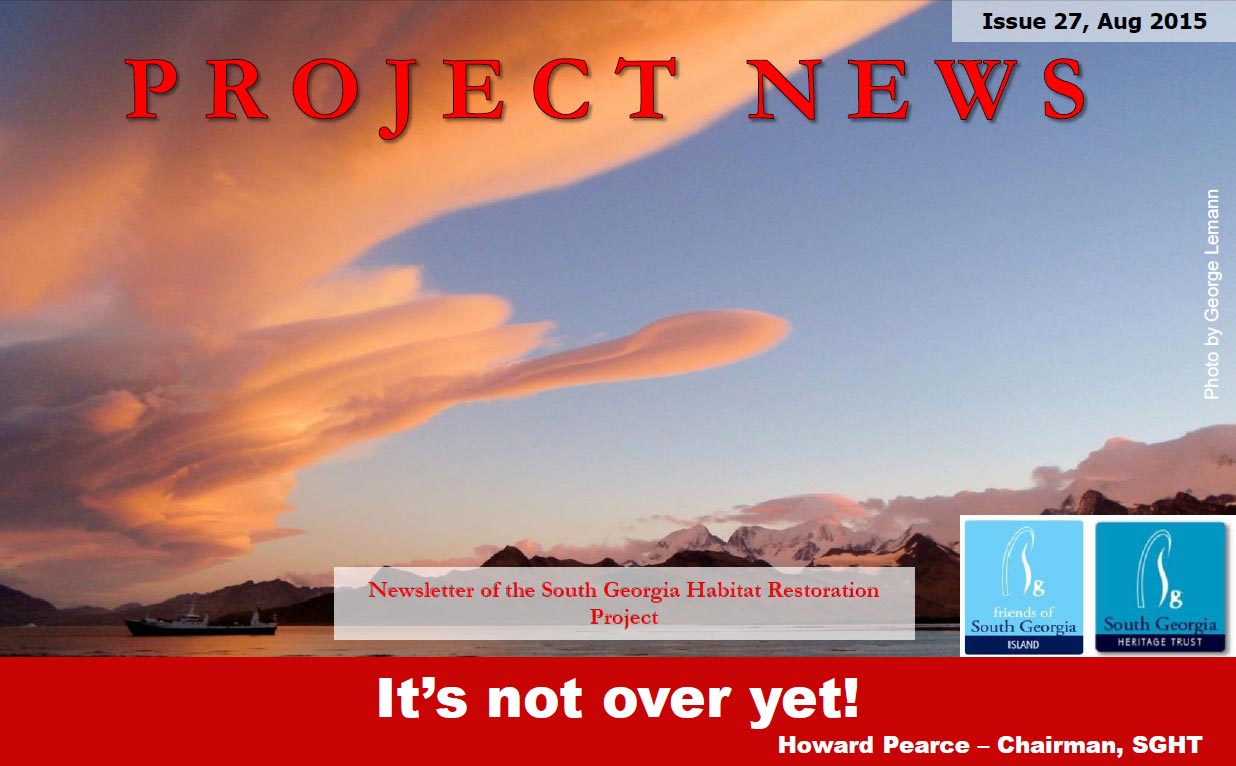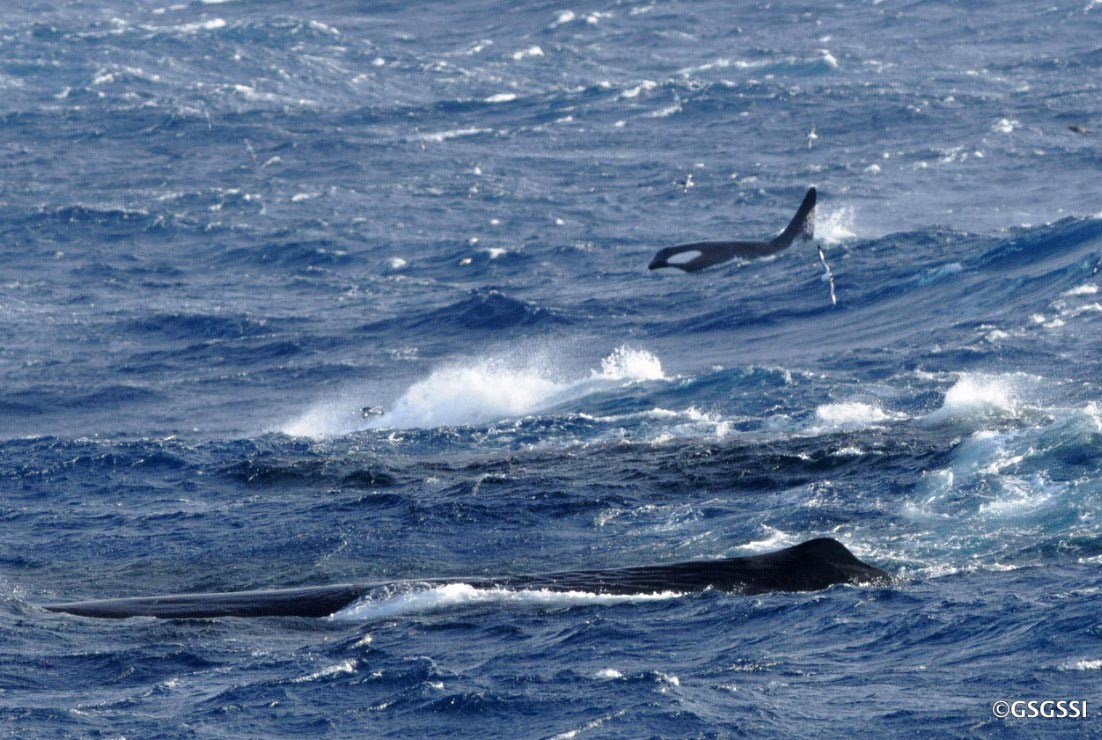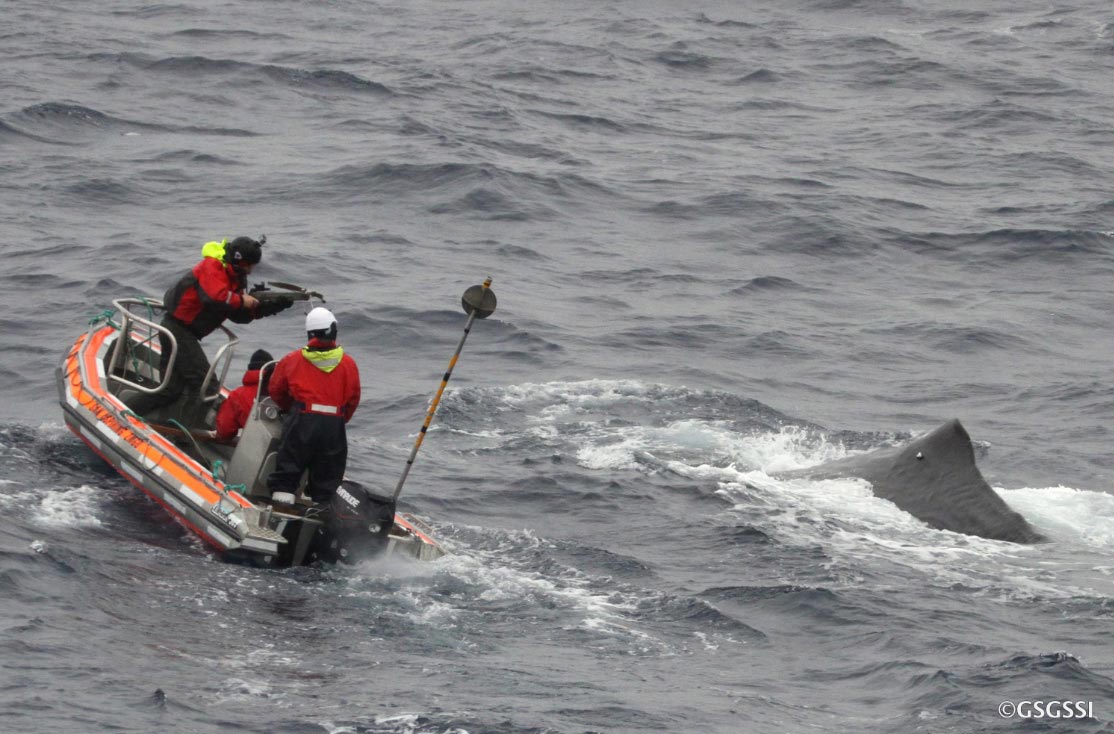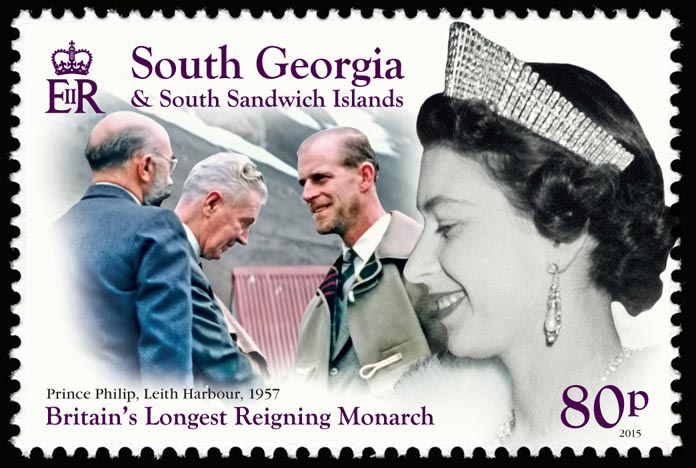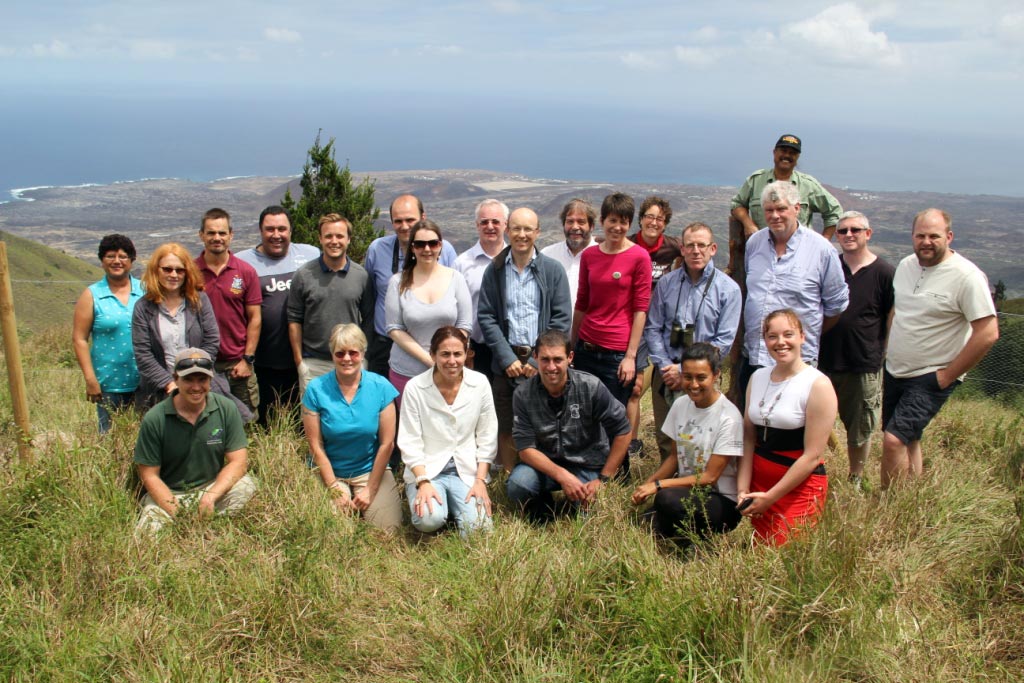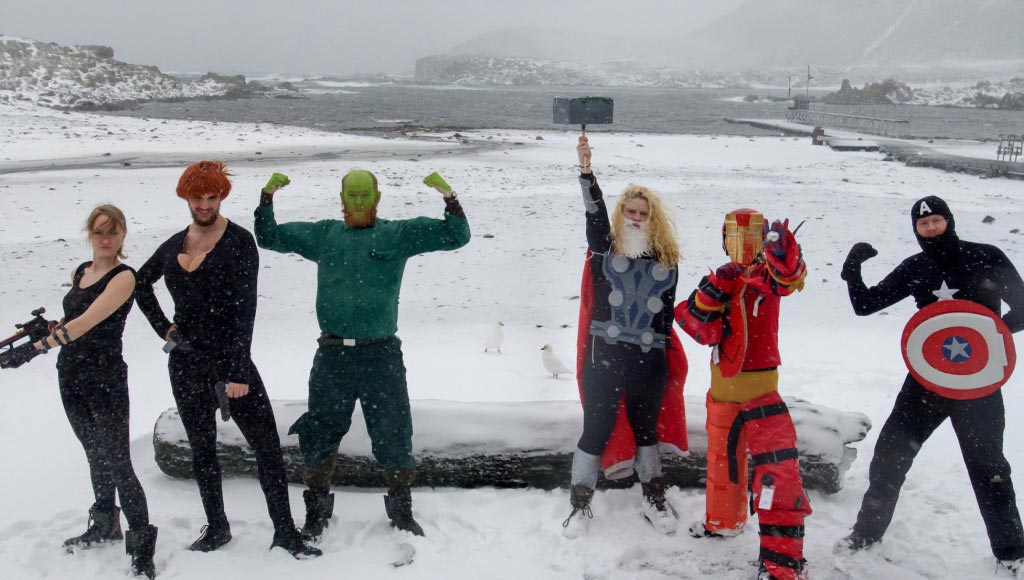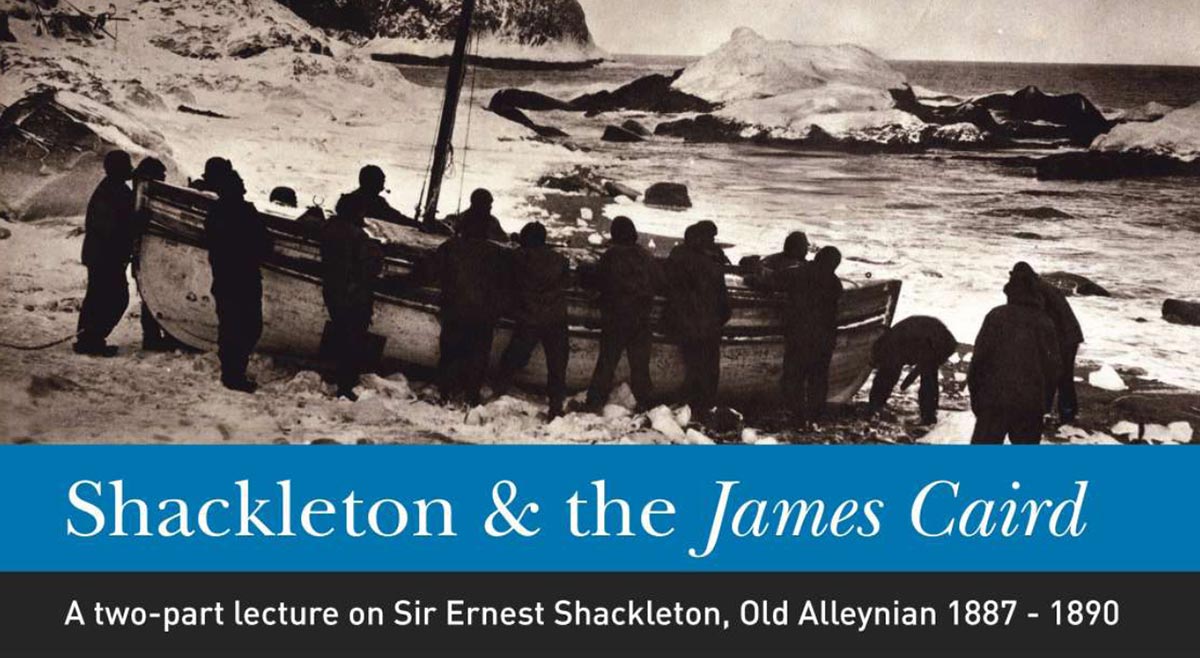This newsletter is not produced by GSGSSI; it does not necessarily reflect their views.
To subscribe to the SGIsland News Alerts list click here
The Commissioner Colin Roberts introduces the 2015 GSGSSI Annual Report by highlighting a busy and successful year “marked with significant achievements across the range of work of GSGSSI.” He said “I am very proud of all in the Government team…Their professionalism and commitment have supported our ambition for South Georgia to continue to be a world leader in environmental management.” He thanked the many partners and stakeholders for their cooperation and contribution. He gave special mention to the South Georgia Heritage Trust for their Habitat Restoration Project, saying the completion of the main baiting phase“…is an achievement of global importance,” noting that GSGSSI is “committed to ensuring that South Georgia benefits from a biosecurity regime which ensures the long-term success of the project.”
Martin Collins, who recently completed his contract with GSGSSI, was also thanked by the Commissioner “for his long and distinguished service as Chief Executive” and new CEO James Jansen was welcomed to the role.
Looking ahead the Commissioner said “I am delighted that so many organisations and individuals have contributed to the development of our Strategy 2016-2020. I welcome the engagement of all who share our objective of better understanding and better protecting this exceptional territory and look forward to delivering the Strategy together in the period ahead.”
The report covers the completion of the GSGSSI Reindeer Project, progress on the Darwin Weed Project and summarises the results of the Round-Island Albatross Surveys. The albatross survey, carried out in December 2014, recorded 15,000 black-browed and 16,000 grey-headed albatross, numbers that show a considerable decline since the previous survey in 2004. Wandering albatross numbers also continue to decline. Also in the report is an overview of: fisheries activity and management; tourism; heritage issues including the GSGSSI building team works around Grytviken; progress on the Legislative Review and a summary of Government finances.
Plans for the year ahead include: finalising the 5-year strategy prior to its launch later in the year; consultation on the Biodiversity Action Plan; further maintenance and building works around Grytviken; a laser survey at Prince Olav Harbour whaling station, also of structures at Ocean Harbour and a completion of the surveys of the stations in Stromness Bay; and continued work on control and eradication of invasive plant species.
The 2015 annual report for GSGSSI was published on this website on August 31st. The 14-page (4.6mb) report can be downloaded here.
 The South Georgia Heritage Trust celebrated its ten-year anniversary with a special logo and message on its website. The charity was legally established as a charitable trust on August 19th 2005.
The South Georgia Heritage Trust celebrated its ten-year anniversary with a special logo and message on its website. The charity was legally established as a charitable trust on August 19th 2005.
Also commemorated was Brigadier David Nicholls, one of the main people to set up SGHT and who died in 2006. Alison Neil, CEO SGHT said the 10th anniversary was, “also a day to remember the man whose energy and vision played such a major part in the creation of the Trust, setting the stage for what we have achieved since”.
The charity took the opportunity to thank its trustees and supporters for enabling the work of the charity on South Georgia. SGHT is currently undertaking the world’s largest rodent eradication on the island.
In the latest edition of ‘Project News’ SGHT are keen to let supporters know that the Habitat Restoration (rodent eradication) project is not yet complete. Chairman Howard Pearce says “It’s Not Over Yet”; the headline on the front page. He goes on to explain, “It is essential that we return to the island to check whether we have indeed succeeded in eradicating every last rat and mouse from South Georgia. Following thorough monitoring we are already confident that the work we did in 2011 has been completely successful. We now need to revisit the areas we baited in 2013 and 2015. We plan to do so towards the end of 2017. By then, a sufficient time will have elapsed for us to be confident that, if any rodents have survived, we shall find them. We need to do this because if there are any survivors, timely action must be taken to deal with them before they spread too far; we must be sure that our donors’ funds have been effective in carrying out the largest such eradication ever attempted; and it will help those who carry out future eradication projects to know what techniques are effective and, if we have failed in any respect.”
The charity still needs to raise the funds to pay for the final work on the project. Howard Pearce said, “We need £300,000 to pay for our team to revisit South Georgia and spend several months in some of the remotest parts of this remote island deploying gnaw sticks, remote cameras, and other sophisticated techniques to detect whether any rodents have survived. We also need funds to meet SGHT’s overheads – office costs and the salaries of our small paid staff – so that we can continue our vital work to protect and conserve South Georgia’s unique natural and historical heritage.”
The latest edition of ‘Project News’ was published on August 27th. It can be downloaded from the SGHT website here.
During the 20th century shore-based whalers at South Georgia removed more whales from the productive waters around the island than were taken anywhere else in the world. Whaling stopped at South Georgia in the 1960s and, with the protection they now receive, populations are slowly recovering. Among those who are witnessing this return at first hand are fishers operating in South Georgia’s sustainable long-line fishery for Patagonian toothfish, certified by the Marine Stewardship Council.
This year the Government of South Georgia and the South Sandwich Islands lead an exciting collaborative project with whale expert, Jared Towers, scientists from USA, and the fishing industry. The project aims to further our understanding of whale behaviour and to help fishing masters to reduce the numbers of fish whales take from their catch. Here Jared tells us about this ground-breaking study.
During the fishing season longliners regularly experience high levels of depredation by killer and sperm whales. Depredation is the technical term for whales taking hooked fish from longlines; it provides a free meal for whales but increases fishing costs and introduces uncertainties to fish stock assessments. It is also of conservation concern because it encourages whales to change their diet and exhibit unnatural feeding behaviour.
To assess and address the problem of depredation around South Georgia, I was deployed on the longliner San Aspiring for 40 days this May and June. I have spent much time with whales since the 1980s, particularly killer whales. Over the last ten years, in addition to directing cetacean research projects for several organizations, I have also worked as a cetacean researcher for the Canadian government. My work has primarily been field-based and focused on the ecology and abundance of populations. Since 2009 I have also been heavily involved with attempts to mitigate interactions between whales and human activities, such as commercial fishing.
Whale depredation on the toothfish fishery has been occurring around South Georgia since the 1990s and there are several things already known about its impact on the fishery. For example, killer whales are known to depredate less frequently than sperm whales but, whereas sperm whales often take only a small portion of the catch, killer whales take nearly every toothfish off the line. The best system in place for deterring this kind of behaviour is simply to stop hauling in the line and leave the area for many hours, hoping that the whales will be gone when you return.
While killer whale numbers at South Georgia appear to have remained relatively constant, the number of sperm whales involved in depredation has increased significantly in recent years. My initial aims were to gain some insights into the number of depredating whales and their movements with the hopes that a greater understanding of their natural history would help the fishing industry to develop avoidance strategies.
In total, I was able to photo-identify over 40 sperm whales, seven of which depredated our lines both to the east and west of South Georgia – areas over 200 miles apart. Additionally, I was able to photo-identify three pods of killer whales, each with over 20 members. Two of these pods took fish of the lines set from San Aspiring on several occasions in different areas around South Georgia. These results suggest that whales are highly mobile and that some may actively target vessels as a primary source of food.
To measure the extent to which whales target vessels as a food supply, and to gain some insights into the dive behaviour of both whale types, I satellite tagged one individual of each species. Preliminary analysis of tag data reveals that both species dive surprisingly deep and that when fishing boats are around the whales spend most their time in areas where fishing occurs. Combining information from photo-identification data with the tag results will teach us valuable information about the ecology of killer and sperm whales at South Georgia, an important first step towards reducing fishery and conservation impacts of the whales behaviour. The remote and inhospitable environment around South Georgia makes this type of research challenging but this project has already proved that it is worth the effort.
On September 9th 2015, Her Majesty Queen Elizabeth II becomes the longest reigning Monarch in British history, surpassing the reign of her great-great-grandmother Queen Victoria. To mark this extraordinary milestone South Georgia and the South Sandwich Islands are releasing a special new stamp issue which is part of a series together with Ascension Island, Bahamas, British Antarctic Territory, Falkland Islands and Tristan da Cunha.
Queen Victoria came to the throne aged 18 and died in 1901 when she was 81, an incredible reign of 63 years and 216 days (23,226 days, 16 hours and 23 minutes) that defined an era and a people. In her journal Victoria recorded that “Today is the day I have reigned longer, by a day, than any English sovereign”. The Victorians responded enthusiastically to her historic milestone yet, like our current Queen, Victoria did not encourage any celebrations ahead of the day.
Yet for Queen Elizabeth II to become the longest reigning of the forty-one kings and queens of England since the Norman Conquest is without doubt an historic achievement. Like Victoria, Elizabeth II is much loved and during a lifetime of service has provided a reassuring and enduring source of stability in a fast and ever changing world.
Elizabeth’s reign has seen more developments, achievements and records than any other. According to Guinness World Records, some of the records she holds include having the most currencies featuring the same individual and her Diamond Jubilee river pageant in 2012 set a new world record for the number of boats in a parade. She has several firsts to her name including: being the first British monarch to have sent an email and to have a message placed on the moon; to have conducted a royal ‘walkabout’; and to have held a public concert in her back garden.
The stamps in the new special issues depict Her Majesty since her coronation with many familiar and iconic images from her reign. The four stamps in the South Georgia set show a portrait of the queen on each and on the 70p stamp it also shows coronation publications from 1953.
The 80p stamp shows Prince Philip, Duke of Edinburgh meeting the doctors at Leith Harbour, where he visited South Georgia aboard the Royal Yacht in 1957. The photograph was taken by John Alexander who was working as an electrician at the whaling station at the time. The stamp also features a portrait of Her Majesty taken at the Embassy in Paris.

The image of Her Majesty was taken at a banquet in Papua New Guinea in 1982. Photo by Tim Graham/Getty Images
The 90p stamp features the ship Queen Elizabeth 2, often referred to simply as QE2, which was an ocean liner from 1969 – 2008 and until 2004 served as Cunard’s flagship. In May 1982 the ship took part in the Falklands Conflict.
She was refitted in Southampton in preparation for war service, including the installation of two helicopter pads, the transformation of public lounges into dormitories, the installation of fuel pipes that ran through the ship down to the engine room to allow for refuelling at sea and the covering of carpets with 2,000 sheets of hardboard. A quarter of the ship’s length was reinforced with steel plating and an anti-magnetic coil was fitted to combat naval mines. Over 650 Cunard crew members volunteered for the voyage to look after the 3,000 members of the Fifth Infantry Brigade the ship transported to South Georgia. During the voyage the ship was blacked out and the radar switched off to avoid detection, steaming on without modern aids. The QE2 returned to the UK in June 1982, where she was greeted in Southampton Water by The Queen Mother on board the Royal Yacht Britannia.
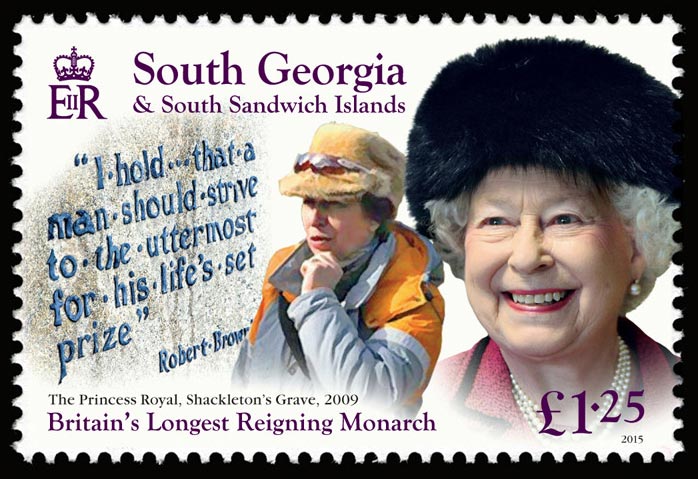
The portrait of Her Majesty on the £1.25 stamp was taken in 2009. Photo by Chris Jackson/Getty Images.
The £1.25 stamp shows The Princess Royal during a visit to South Georgia in 2009 at the invitation of the SGHT. She is patron on the charity. She visited Shackleton’s grave and here you can see the wording from the back of his gravestone.
Between 14th and 18th of August environmental representatives from UK Overseas Territory governments of St Helena, Tristan da Cunha, Falkland Islands, Ascension Island and South Georgia & the South Sandwich Islands (SGSSI) gathered together at a regional biosecurity workshop together with UK government staff with relevant technical expertise, key suppliers and NGOs (Fig x). The workshop was hosted by the Ascension Island Government and funded by the Joint Nature Conservation Committee. Environment Officer Jennifer Lee and Government Officer Simon Browning represented GSGSSI.
Biosecurity is an important issue for many Overseas Territories. The main objectives of the workshop were to share experience and good practice in the region; improve the biosecurity of the participating Overseas Territories; explore the potential for a regional approach to biosecurity, building on the 2009 Regional South Atlantic Invasive Species Strategy; and to develop collaborations needed to further biosecurity in each Territory.
Over the 5-days workshop sessions were held on biosecurity policy, risk assessments, marine biosecurity, methods for early detection and rapid response to incursions and approaches to raise awareness of biosecurity with stakeholders and improve compliance.
Because of the recent hard work on projects to eradicate rodents, reindeer and invasive weeds the need for stringent biosecurity and developing robust biosecurity policy is a top priority for GSGSSI. Simon and Jennifer were able to share many of the lessons learned on SGSSI with the rest of the group, receive feedback existing policies and learn lessons from what has been successful elsewhere. Throughout the week, the productive, collaborative working relationships within the GSGSSI team and with stakeholders such as the British Antarctic Survey, MoD, IAATO and Falkland Island Government was identified as a key strength.
A key take-home message from the workshop was that the most effective biosecurity involved simple but clear protocols that are straightforward to implement. These protocols need to be underpinned by legislation, as it is on SGSSI under the Wildlife and Protected Areas Ordinance, and provision should be made for spot-checks to ensure compliance and regular review to ensure policy remains fit for purpose.
Drawing on the feedback from the workshop and its on going review of biosecurity, GSGSSI are now in the process of drafting a comprehensive biosecurity handbook. The aim of this document is to bring together policies and procedures from all areas of operations, making it easy for users to see what biosecurity measures are in place and understand how they can help protect SGSSI biodiversity from invasive species.
 The Agreement on the Conservation of Albatrosses and Petrels (ACAP) has been running for more than ten years now and has 13 participating countries. Over the period since its inception considerable progress has been made towards conserving endangered bird species.
The Agreement on the Conservation of Albatrosses and Petrels (ACAP) has been running for more than ten years now and has 13 participating countries. Over the period since its inception considerable progress has been made towards conserving endangered bird species.
ACAP has just published a booklet outlining the achievements. ACAP’s Executive Secretary, Warren Papworth, and Executive Secretary Elect Marco Favero wrote the introduction to the booklet and they say the reports in the booklet reveal the “significant progress made by ACAP Parties in addressing threats to the survival of albatrosses and petrels, both on land and at sea.” The pair say, “The Agreement has played a crucial role in bringing together a global network of researchers and managers to identify threats to albatrosses and petrels, to prioritize conservation actions and to find effective solutions to them. Through the work of its Seabird Bycatch Working Group, it has identified effective measures that can be taken to prevent the bycatch of seabirds in longline and trawl fisheries, which together pose the greatest at-sea threat to the survival of many albatrosses and petrels. Similarly, ACAP’s Population and Conservation Status Working Group has developed guidelines that identify best-practice methods to address land-based threats at the breeding sites of these species. Significant progress has been achieved at some important breeding sites, where large-scale pest eradication programmes have been completed. The success of these programmes has in some cases been immediately noticeable, with a number of species returning to breed on these islands following the successful completion of the pest-eradication programmes.”
There is still work to be done however the booklet introduction also states, “Threats from disease and introduced pests still threaten the survival of some species and it is important that the work of ACAP Parties continues at these breeding sites in the years ahead until these threats are addressed.”
The Agreement has been instrumental in coordinating the development of effective seabird conservation measures in both domestic and high seas fisheries. As a result of this work fisheries that overlap with the foraging areas of albatrosses and petrels have adopted seabird conservation measures based on ACAP’s best-practice advice. But they warn that, “a lack of data has made it difficult to evaluate the extent to which these conservation measures have been implemented in many fisheries. To achieve ACAP’s objective of achieving and maintaining a favourable conservation status of albatrosses and petrels, it is essential that effective observer programmes and/or electronic monitoring programmes be put in place.
The Convention on the Conservation of Antarctic Marine Living Resources (CCAMLR), which has 100% observer coverage in its longline fishing operations, such as those in South Georgia waters, have proved that the reduction of seabird bycatch to nil or negligible levels is possible including in high seas fisheries. The ACAP officers therefore say, “ACAP’s focus in the coming years must be to see this success replicated in other fisheries, to continue its work in addressing threats at breeding sites and to seek the active participation of those Range States who are not yet engaged in its work.”
ACAP’s booklet ‘Achievements in the First Ten Years 2004 – 2014’ is arranged in sections for participating countries. For each country it sets out their key achievements and challenges ahead. In the United Kingdom section it highlights the work done on South Georgia and in the Falkland Islands to eradicate rodents from bird breeding areas, and the research on the bird species. In the challenges section it lists eradicating house mice from Gough Island (Tristan Island Group) as the “greatest immediate challenge facing the UK.”, and also “ensuring the success of the rodent eradication at South Georgia.” as, “eradication programmes are expensive and carry a risk of failure due to the complex logistics and unpredictability of local weather conditions.”
The booklet celebrating the achievements of ACAP can be downloaded from their website here.
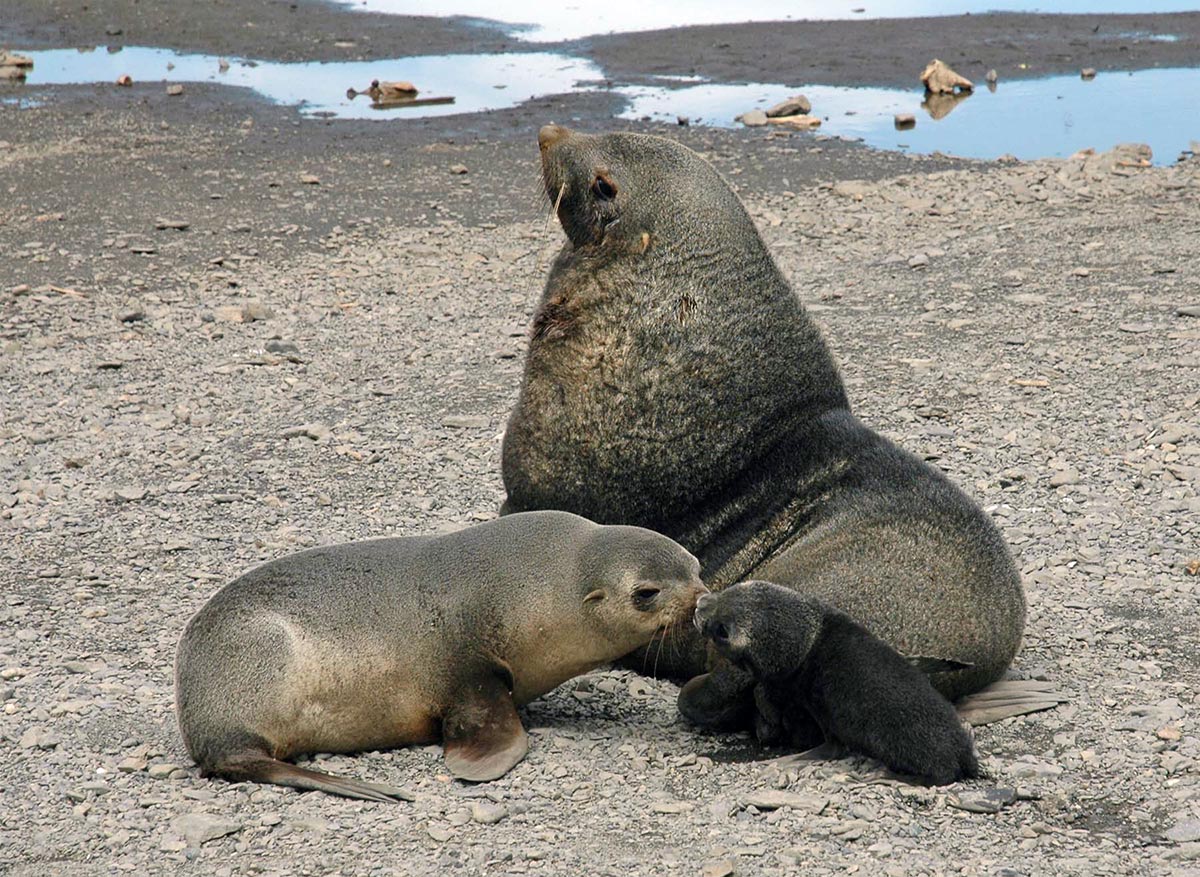
These fur seals use scent to recognise each other. Photo David Vaynor Evans, British Antarctic Survey.
New research shows that fur seals use their sense of smell far more than was previously thought.
Mothers returning from foraging trips of up to ten days return to the area where their pup was born, but the pups can move quite a distance whilst the mothers are away, especially as they get older. Returning mothers call, and the answering bleats of the pups ring out around the island’s beaches in summertime, so scientist had thought the animals’ vocalisations were the main way they found each other in the crowd. Now research conducted on Bird Island shows that mothers and pups have very similar smells and that mothers use smell as a way of recognising their own pup amongst the multitude of similar-looking pups on one beach. The scientists were surprised to find scent is so important in an animal that spends the vast majority of its time in the water.
Understanding communication by smell is very challenging because of the mixture of chemicals on an animal’s skin – the individual seal’s scent may be affected by hormones, microbial flora, body condition and health, and environmental factors.
To test the importance of smell researchers from the University of Bielefeld and the British Antarctic Survey (BAS) sampled the skin and fur from mothers and their pups in two different colonies. They found the scent of mothers and pups had similar characteristics. Martin Stoffel, lead author of a paper on the study, said, “Our results show that fur seal pups smell similar to their mothers as many of the chemicals on their skin are shared and genetically encoded. Also, individuals with high genetic variability have a more complex scent profile, meaning they have a greater number of substances on their skin.” She went on to explain that a more complex scent could be significant when it comes to being chosen as a mate to breed, suggesting that those seals with more complex scents could be more attractive to other seals because the complex scent shows them to be more genetic diverse – a feature that is “often positively correlated with survival.”
Co-author Dr Barbara Caspers, who specialises in communication through smell, also pointed out that scent may help to prevent in-breeding. Seals that had similar smells may not choose to breed with each other: “The idea that scent signals relatedness has been around for a long time”, she said, “but this has not been chemically proven until now. In evolutionary history, the sense of smell is the first sense. There is reason to believe the mechanisms are similar across the animal kingdom and not just fur seals.”
The paper ‘Chemical fingerprints encode mother-offspring similarity, colony membership, relatedness and genetic quality in fur seals’ was published on August 10th in the Proceedings of the National Academy of Sciences.
INFO BAS
New GSGSSI Website: GSGSSI is proud to launch its new fresh website. The new website has an updated design and branding, and is easier to navigate and search, providing a more accessible portal for those interested in finding out more about this UK Overseas Territory. It also has more photographs capturing stunning wildlife and landscapes. For those on the move, the site is optimized for viewing and using on mobile phones. The content has also been updated, providing the latest information in key areas of interest including visiting, the environment, fisheries and science. Over 250 documents are available to download in the document library and a live search function makes it easy to find what you are looking for.
Winter pipit at KEP: Residents at King Edward Point (KEP) have had the company of a South Georgia pipit on the Point throughout the winter. This endemic bird seems to have returned to the Thatcher Peninsula area last summer as several birds were regularly seen in the area from mid-summer onwards, but pipits have not been seen in the area in wintertime for possibly as long as a century or longer. Their presence in winter is yet another sign of the success of the SGHT Habitat Restoration Project which baited the area to remove invasive rodents more than four years ago. It seems to have taken the tiny bird a long time to resettle this area as in other parts of the main island pipits were seen to return and recolonize within months of baiting.
Now, at KEP, it is possible to go out and regularly hear the little brown bird singing from the top of a tussac grass plant surrounded by the winter snow.
There is still a bottle of champagne to be claimed for the first pipit nest on the Thatcher Peninsula. The prize is offered by the South Georgia Association (SGA). Perhaps the now vintage bottle will be claimed in the summer ahead!
The Avengers and The Princess and the Can of Peas: The Midwinter Film Festival was once again a source of entertainment and hard work one August weekend. All over the Antarctic region the international bases got busy filming their five-minute long films. This year the entrants were asked to include four elements and these were only circulated on the Friday afternoon so no one could get ahead of the game. The films had to include a toilet seat, garden peas, the line of dialogue “It’s a complicated algorithm”, and a “boing” sound. By the end of Sunday night 34 films had been uploaded to the judging site. Over the next couple of weeks the stations downloaded these and were asked to judge them for: best film; best acting; most novel use of the elements; and best love scene!
The KEP entry was called “The Princess and the Can of Peas” and features knights in shining armour (okay tinfoil used to good effect). The Bird island entry was called “Long Term Monitoring” and also made good use of homemade costumes as the folks turned themselves into the Avengers.
Once the judging was complete Bird Island in particular were very pleased. The base members described themselves as, “…beyond thrilled, and indeed shocked” to get second place for Best Film, second place for best Love Scene, second place for best use of the elements and to top all that they won the Best acting award. Winter Station Leader Alastair Wilson said, “Of all the many, many skills that I have acquired whilst working for BAS, never did I think I would be able to legitimately add to my CV, “Award winning film director” – but turns out, when you work for BAS, anything is possible.”
You can see all the 48hr film festival entries here.
A hundred years ago Shackleton’s Imperial Trans-Antarctic Expedition was underway and so most of the events highlighted in this section relate to Shackleton Centenary events. Shackleton had strong links with South Georgia and is buried at Grytviken.
 The Pursuit of Endurance: There will be a special screening of the documentary ‘The Pursuit of Endurance’ on September 14th in New York City, USA. The screening takes place on the eve of the opening of the 70th Regular Session of the UN General Assembly at the United Nations’ Headquarters.
The Pursuit of Endurance: There will be a special screening of the documentary ‘The Pursuit of Endurance’ on September 14th in New York City, USA. The screening takes place on the eve of the opening of the 70th Regular Session of the UN General Assembly at the United Nations’ Headquarters.
The documentary follows nine adventurers from very different backgrounds who set out to experience some of what Shackleton and the shipwrecked crew of Endurance did at Elephant Island and South Georgia. The documentary by Bertrand Delapierre is being shown under the High Patronage of His Excellency François Delattre, Ambassador and Permanent Representative of France to the United Nations and is hosted by The Association des Français Fonctionnaires Internationaux de New York (AFFIN). There will be an introduction by His Excellency François Delattre. After the film there will be a question and answer session with film producer Luc Hardy about the film, climate change and the COP21 conference.
The event starts at 6.30pm to 8.30 pm. Although the event is free to attend you will need to take ID or a passport. You also need to reserve seat at: https://www.eventbrite.com/e/the-pursuit-of-endurance-at-united-nations-tickets-18099006616
You can watch the film trailer here.
Shackleton and the James Caird: On October 6th there will be a two-part lecture on Sir Ernest Shackleton and the James Caird at Dulwich College, London. The first lecture is entitled ‘Shackleton: Engineering Success out of Defeat” and is presented by Seb Coulthard who was the expedition engineer on the 2013 Shackleton Epic expedition. The second lecture is by Simon Stephens, Curator of the Ship Model and Boat Collections at the National Maritime Museum, and is entitled ‘Life after Shackleton: The Conservation and Travels of the James Caird’. The lectures are part of the GE Moore lecture series celebrating the 400th anniversary of Dulwich College in 2019.
The Shackleton and the James Caird two-part lecture starts with a drink reception at 6.45pm. Tickets cost £10 and are available from lectureseries@dulwich.org.uk
The Yorkshire Ones in Antarctica: An exhibition to commemorate Shackleton’s Endurance Expedition through art and to commemorate the Hull locals involved in the expedition. The artists, whose works include textiles, ceramics and metal works are also mainly local. The exhibition is running until the end of October at the Hull Maritime Museum. Open daily.
By Endurance we Conquer: Shackleton and his men: The Polar Museum at Scott Polar Research Institute in Cambridge will host a centenary exhibition to commemorate all the men that sailed with Shackleton aboard the Endurance. The men in the Ross Sea Party who laid the supply depots for the planned crossing of the Antarctic continent, three of whom lost their lives, will also be commemorated.
The exhibition opens on September 22nd and will run until June 18th 2016.
Recent Voyages South: The Devon and Cornwall Polar Society are holding an event on at 7.30pm on Thursday 15th October at the Duke of Cornwall Hotel, Plymouth . The ‘Recent Voyages South’ talks will be by Paul Davies and Tim Burr who will speak about their travels with the Shackleton Centenary Expedition and Denis Wilkins on the FIDS (Falkland Island Dependencies Survey) reunion and dedication of the memorial in Stanley, FI to FIDS who lost their lives in pursuit of science. More information here.
Penguin City Weekend: A Shackleton themed weekend in Edinburgh, Scotland is being organised by the South Georgia Association and is open to everyone.
Edinburgh has many links with South Georgia and to Sir Ernest Shackleton. The two-day meeting will be centred on Edinburgh Zoo.
The weekend event is on Friday 30th and Saturday 31st October 2015 and is expected to be popular. Numbers are limited so apply early, email bfm@dahlstrom-mair.com
(Please note that the email contact address was incorrect in some earlier editions of this newsletter, so if you attempted to get in touch and did not get a response please write again to the email address above.)
Thursday August 27th marked the 100th year Anniversary of Frank Hurley’s incredible photograph entitled “The long, long night”, shown below. It shows the Endurance trapped in the pack-ice of the Weddell Sea, during the Antarctic winter darkness. Of taking the picture Frank Hurley, the expedition photographer wrote: “During the night take flashlight of ship beset by pressure. This necessitated some 20 flashes, one behind each salient pressure hummock, no less than 10 flashes being required to satisfactorily illuminate the ship herself. Half blinded after the successive flashes, I lost my bearings amidst hummocks, bumping shins against projecting ice points & stumbling into deep snow drifts.”
With thanks to www.facebook.com/Shackletonexhibition



